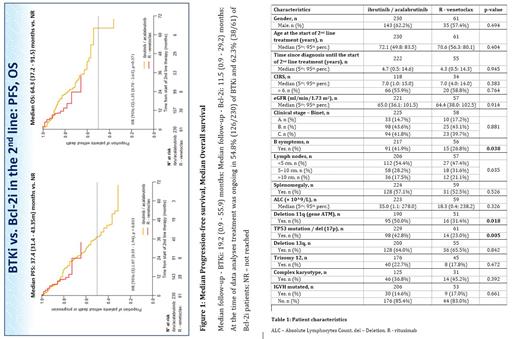Introduction:
Venetoclax in combination with rituximab (VenR) along with either ibrutinib or acalabrutinib monotherapy represent the most common regimens currently used for the treatment of relapsed/refractory (RR) chronic lymphocytic leukemia (CLL) in the Czech Republic. As all of these regimens are approved for identical indications in RR CLL, the selection of the most appropriate treatment depends on the drug toxicity profile and patient´s comorbidities.
Methods:
We conducted a retrospective analysis of data from the Czech National Registry of CLL patients (CLLEAR). Patients were treated in one of eight Czech hematological centres between December 2015 and June 2023. Only those who received chemoimmunotherapy in the first-line and Bruton tyrosine kinase inhibitor (BTKi) or Bcl-2 inhibitor (Bcl-2i) in the second-line treatment were included in the study. All patients fulfilled iwCLL diagnostic criteria and had provided informed consent before their data were captured in the CLLEAR. Key CLL-related clinical and laboratory parameters were obtained from the database (Table 1). Ibrutinib and acalabrutinib monotherapy were given at standard doses until disease progression (PD) or unacceptable toxicity. The combination of venetoclax and rituximab (VenR) was administered in the regular dosing schedule for 24 months.
Results:
Out of 291 patients included in the study, 70.1% (204/291) were treated with ibrutinib, 8.9% (26/291) received acalabrutinib and 20.9% (61/291) VenR. The median age at the start of the second-line treatment was 72.1 and 70.6 years, respectively (BTKi and Bcl-2i). There were no significant differences in sex, clinical stage, CIRS, creatinine clearance and time since diagnosis until the beginning of the second-line treatment. Bendamustine and rituximab followed by fludarabine, cyclophosphamide and rituximab were the most common regimens used in the firs-line treatment. Deletion (del) 17p and/or TP53 mutation, and del 11q were more frequent in the BTKi cohort, while unmutated IGVH gene was detected similarly in both groups (Table 1). Median follow-up was longer in BTKi than in Bcl-2i group (19.2 vs. 11.5 months). The overall response rate (ORR) was evaluated in 191 patients treated with BTKi and in 42 patients treated with Bcl-2i for at least six months. The ORR was comparable between the BTKi and Bcl-2i cohort, 90.6% (173/191) vs. 92.9% (39/42) (p = 0.774). More complete remissions (CR) were seen in Bcl-2i group, 12.0% (23/191) vs. 42.9% (18/42) (p<0.001). Median progression-free survival (mPFS) was 37.4 (31.4 - 43.35) months vs. not reached (BTKi vs Bcl-2i), HR 1.07 (95% CI, 0.59 - 1.94) (p = 0.833, Figure 1). Median overall survival (mOS) was 64.3 (37.2 - 91.5) months vs. not reached (BTKi vs Bcl-2i), HR 1.35 (95% CI 0.70 - 2.63) (p=0.371, Figure 1). Similar results were observed in the subgroup with del17p and/or TP53 mutation (mPFS: 35.6 months vs. not reached, HR 1.80, 95% CI, 0.69 - 4.69), as well as in the subgroup with unmutated IGVH gene (mPFS: 35.6 months vs. not reached, HR 1.36, 95% CI, 0.72 - 2.55). At the time of data analysis, hematological toxicity and infectious complications were premature for comparison (data were assessed in 31.3% of BTKi and 57.4% of Bcl-2i patients). Grade III-IV hypertension and other non-hematological toxicity (excluding infections) prevailed in BTKi cohort (19.2% BTKi, 9.6% Bcl-2i). The median treatment duration of BTKi and Bcl-2i was 14.7 (0.7 - 53.4) and 9.7 (0.3 - 25.8) months, respectively. Early discontinuation was observed more frequently post BTKi compared to post Bcl-2i administration, 43.9% (101/230) vs. 26.2% (16/61) (p<0.001). Except for the progression (24.8% BTKi, 18.8% Bcl-2i), the most common causes leading to premature discontinuation were death (23.8% BTKi, 12.5% Bcl-2i), infection (9.99% BTKi, 37.5% Bcl-2i), and non-hematological toxicity (24.8% BTKi, 6.3% Bcl-2i).
Conclusion:
In terms of high-risk prognostic markers, a higher prevalence of del 17p and/or TP53 mutation, and del 11q were observed in the BTKi cohort. In contrast, frequency of the unmutated IGVH gene was comparable in both groups. Difference in median PFS and OS was not statistically significant within the current follow-up period. However, premature termination of treatment was more commonly seen in BTKi group. To confirm our primary outcomes, longer follow-up is warranted.
Disclosures
Mocikova:MSD: Research Funding.


This feature is available to Subscribers Only
Sign In or Create an Account Close Modal